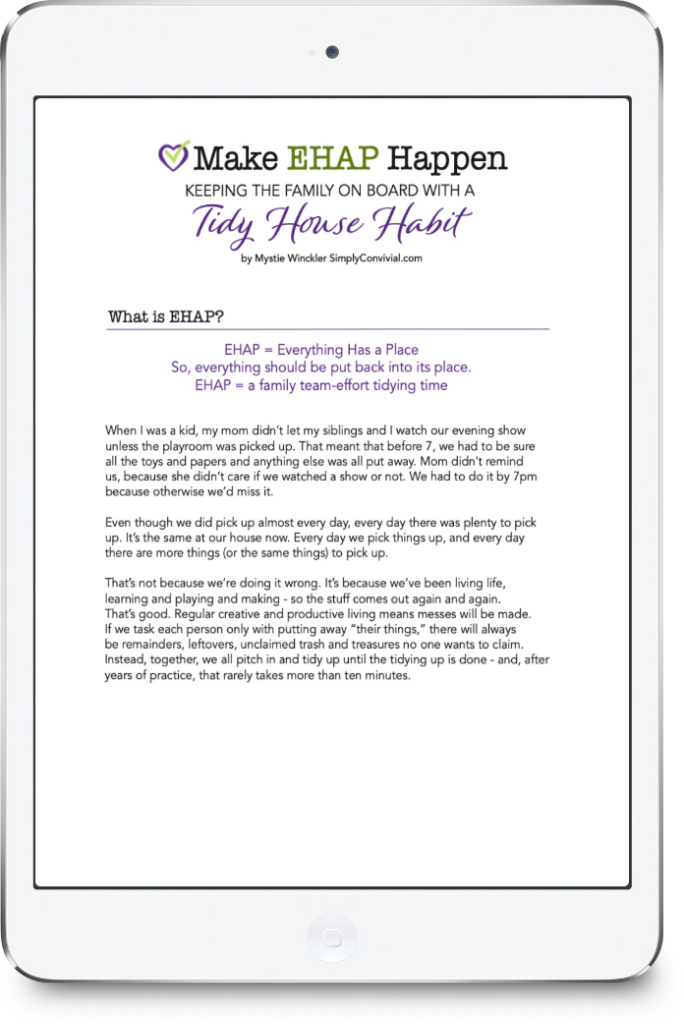We have a small practice that saves the state of our house, almost every day. It’s simple and effective – as long as we do it. When I keep the time in the late afternoon regularly carved out for it, I can handle the intermittent chaos that descends as the kids work and play throughout the day. I know order will be restored, so I can take a deep breath and let them strew blankets and play food everywhere.
I call this practice EHAP.
We pronounce it ee-hap, like it was some sort of military maneuver. In a way, it is. I deploy my children and we go on a seek-and-put-away mission.
EHAP stands for Everything Has A Place. Of course, the implication is that everything should be in its place. It’s a little family-lingo for tidying up. If I ask them to EHAP, and then come in to see that not everything is in its place, then the room has not been EHAPed.
So it’s a code word for returning anything out of place to its place, whether it be furniture, books, blankets, or toys. Nothing is exempt.
We’ve recently refined our practice and now refer to it as EHAP5 – a special kind of EHAP.
- 5 people (4 kids + mom)
- 5 minutes per area (we use a timer)
- at 5pm
Listen to this post!
Mom does EHAP with the kids
When I do EHAP with them, I can direct the younger ones to specific tasks so they stay moving and not dawdling, I can dust and put furniture where I want it, I can make sure they don’t shove anything under the couch, and I can prevent sibling bickering from breaking out.
In years past I resisted doing EHAP myself. I wanted to send the kids out while I was making dinner or folding laundry and have them do it on their own. But the less supervision they have, the less likely they are to do a complete and thorough job.
In the end, doing it with them means the job is done faster, everyone participates more equally, and I add a little extra cleaning as I go that I normally don’t get to.
EHAP with a timer
It’s amazing how motivational a timer can be. There have been years where the kids groan when I gather them up for EHAP, but when we use a timer and I say, “Ok. EHAP the wood floor zone. 5 minutes. Go!” Everyone is much more likely to move quickly and tackle the project with gusto.
Yes, I tell them after 5 minutes is up, they are done, even if the room is not fully EHAPed. Most of the time, it is, and we finish before the timer chimes. After all, it’s 5 people – that’s 25 minutes of manpower, and if we do it every day, it’s never infrequently a total disaster.
When everyone knows the misery is short and will be over – and they even have a chance of beating the timer and being done in LESS time – they can get down to business with a good will.
EHAP in zones
Resist the urge to spread your crew out and cover more ground simultaneously. Keep especially the younger set nearby so you can point out what they should do. Anyone under 8 or anyone with little practice at any age will need concrete tasks and direction.
It is also a good idea to not let the less trustworthy or more dawdling-prone of the children out of your sight at all, even to put something a way. One way to break it up is to have the younger ones in charge of looking underneath all the furniture and behind chairs and cushions, making a pile in the center of the room for the bigger kids to put away. Then you can direct those more apt to wander aimlessly to put away the items that belong in the same room, within sight.
So we break up the public areas of our house into three zones. The mudroom, kitchen, & eat-in area all share tile floor and form a rectangle in half of our main level. It is The Tile Floor Zone. The dining room, living room, and entry are all open and have wood floor and comprise the remainder of the main level. It is The Wood Floor Zone. Finally, the basement family room area is the last public area of the house, and it is The Playroom Zone.
So, at 5 minutes per zone, we can have all the public areas of the house tidied up in 15 minutes.
Not bad. Give it a shot and see if it works for you, too!

Want a Tidier House?
- Get clear where and when your family needs to tidy up.
- Bring the kids on board to take responsibility for tidying more than their own stuff.
- Learn the three steps to make the habit stick for the long haul.
